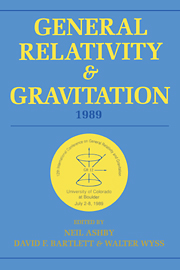 General Relativity and Gravitation, 1989
General Relativity and Gravitation, 1989 Book contents
- Frontmatter
- Contents
- Preface
- Conference committees
- Part A Classical relativity and gravitation theory
- WORKSHOPS
- Part B Relativistic astrophysics, early universe, and classical cosmology
- WORKSHOPS
- Part C Experimental gravitation and gravitational wave detection
- WORKSHOPS
- Part D Quantum gravity, superstrings, quantum cosmology
- WORKSHOPS
- D1 Theories of quantum gravity I (superstring theory)
- D2 New Hamiltonian variables
- D3 Quantum cosmology and baby universes
- D4 Quantum field theory in curved spacetime
- D5 Theories of quantum gravity II (not superstring theory)
- Part E Overviews-past, present, and future
D1 - Theories of quantum gravity I (superstring theory)
Published online by Cambridge University Press: 05 March 2012
- Frontmatter
- Contents
- Preface
- Conference committees
- Part A Classical relativity and gravitation theory
- WORKSHOPS
- Part B Relativistic astrophysics, early universe, and classical cosmology
- WORKSHOPS
- Part C Experimental gravitation and gravitational wave detection
- WORKSHOPS
- Part D Quantum gravity, superstrings, quantum cosmology
- WORKSHOPS
- D1 Theories of quantum gravity I (superstring theory)
- D2 New Hamiltonian variables
- D3 Quantum cosmology and baby universes
- D4 Quantum field theory in curved spacetime
- D5 Theories of quantum gravity II (not superstring theory)
- Part E Overviews-past, present, and future
Summary
Superstrings continue to be a source of inspiration for the basic understanding of quantum gravity. They seem to provide a more fundamental arena than quantum field theory. Even though we still do not have a theory of everything, string concepts bring a new theoretical richness to research in quantum and classical gravity.
Based in previous work on general gauge theories, S. Ichinose analyzed in this session 2D conformal gravity centering his attention on gauge fixing, physical quantities, the energy momentum tensor, and renormalization. C. G. Torre in his talk presented a new formulation of Hamiltonian 2D-gravity which is covariant under all the relevant groups: the spacetime diffeomorphism group, the slice diffeomorphism, and the group of conformal isometries. The key ingredients that allow covariance with respect to the above groups are the enlargement of the phase space by the inclusion of the cotangent bundle over the space of embeddings of a Cauchy surface into the spacetime and the extensive use of conformal 2D isometries.
I. Bakas showed that the Sugawara formalism used in 2D conformal field theory to construct the stress-energy tensor of some non-linear σ-models may have a natural geometric interpretation as a gauge fixing mechanism for current algebras. In the simplest case (SL(2,C)) this procedure provides a realization of the diffeomorphism group of the circle in terms of a 2-D non linear σ-model. Its connection with the choice of the variables proposed by Isham, Klauder and others in the context of canonical quantum gravity was discussed.
- Type
- Chapter
- Information
- General Relativity and Gravitation, 1989Proceedings of the 12th International Conference on General Relativity and Gravitation, pp. 441 - 448Publisher: Cambridge University PressPrint publication year: 1990
